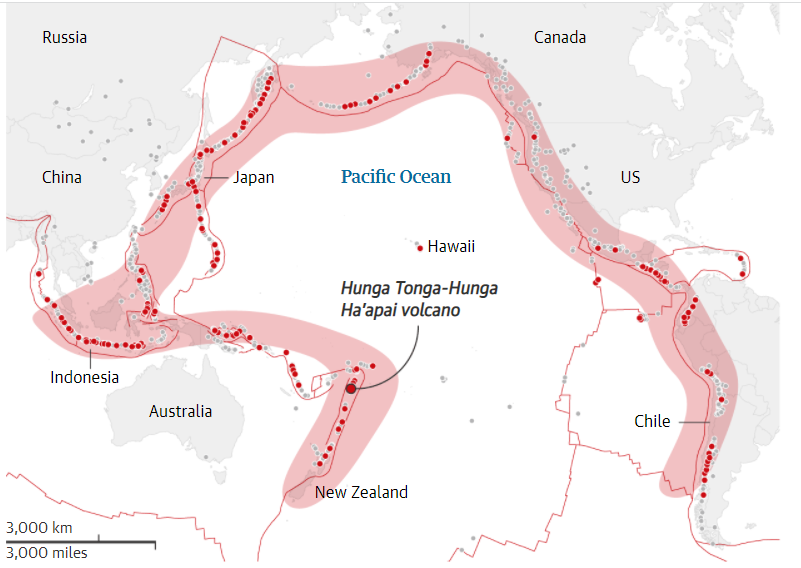Important Facts For Prelims
Volcanic Eruption in Tonga
- 17 Jan 2022
- 4 min read
Why in News
Recently, a volcano erupted in the southern Pacific Island of Tonga, which triggered Tsunami waves around the Pacific.
- The Tonga Islands occur along the Ring of Fire—a perimeter of heightened volcanic and seismic activity that encircles the Pacific Ocean basin.
Key Points
- About:
- It is an Undersea Volcanic Eruption consisting of two small uninhabited islands, Hunga-Ha’apai and Hunga-Tonga.
- The Hunga-Tonga-Hunga-Ha’apai volcano has erupted regularly over the past few decades.
- During events in 2009 and 2014/15, hot jets of magma and steam exploded through the waves. But these eruptions were small, dwarfed in scale by the January 2022 events.
- This is one of the massive explosions the volcano is capable of producing roughly every thousand years.
- One of the reasons for it being highly explosive is the Fuel-Coolant interaction.
- Impact:
- Huge volcanic eruptions can sometimes cause temporary global cooling as sulfur dioxide is pumped into the stratosphere. But in the case of the Tonga eruption, initial satellite measurements indicated the amount of sulfur dioxide released would only have a tiny effect of perhaps 0.01 Celsius global average cooling.
- The eruption altered atmospheric pressure that may have briefly helped clear out the fog in Seattle, in the United States.
- The waves crossed the Pacific, drowning two people in Peru and causing minor damage from New Zealand to Santa Cruz, California.
- The US Geological Survey estimated the eruption caused the equivalent of a magnitude 5.8 earthquake.
Volcano
- A volcano is an opening or rupture in the earth’s surface that allows magma - which comes out as hot liquid and semi-liquid rock - volcanic ash and gases to escape.
- The volcanic hotspots are places which are found where Earth’s tectonic plates come together.
- A volcanic eruption is when lava and gas are released from a volcano - sometimes explosively.
Undersea Volcano
- The undersea volcanic eruption happens in a volcano which is located under the ocean surface. There are an estimated one million undersea volcanoes, and most of them are located near the tectonic plates.
- Apart from lava, these openings also spew out ash. These deposit on the ocean’s floor and lead to the formation of sea mounds - underwater mountains that are formed on the ocean floor but do not reach the water surface.
Fuel-Coolant Interaction
- If magma rises into sea water slowly, even at temperatures of about 1200 degrees Celsius, a thin film of steam forms between the magma and water. This provides a layer of insulation to allow the outer surface of the magma to cool. But this process doesn’t work when magma is blasted out of the ground full of volcanic gas.
- When magma enters the water rapidly, any steam layers are quickly disrupted, bringing hot magma in direct contact with cold water.
- It is akin to weapons-grade chemical explosions.
- Extremely violent blasts tear the magma apart.
- A chain reaction begins, with new magma fragments exposing fresh hot interior surfaces to water, and the explosions repeat, ultimately jetting out volcanic particles and causing blasts with supersonic speeds.





